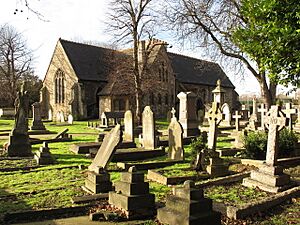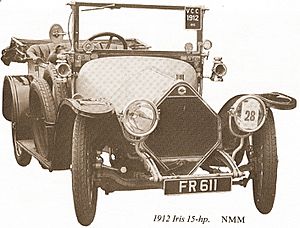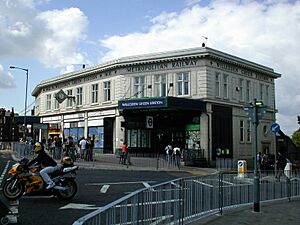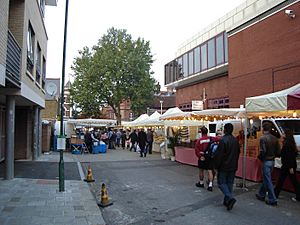Willesden facts for kids
Quick facts for kids Willesden |
|
|---|---|
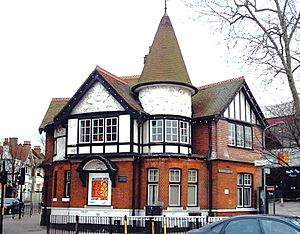 Willesden Green Old Library Building |
|
| OS grid reference | TQ227846 |
| London borough | |
| Ceremonial county | Greater London |
| Region | |
| Country | England |
| Sovereign state | United Kingdom |
| Post town | LONDON |
| Postcode district | NW10, NW2 |
| Dialling code | 020 |
| Police | Metropolitan |
| Fire | London |
| Ambulance | London |
| EU Parliament | London |
| UK Parliament | |
| London Assembly |
|
Willesden is an area in north-west London, about 5 miles (8 km) from the city center. It used to be a separate parish in Middlesex county. In 1933, it became the Municipal Borough of Willesden. Since 1965, it has been part of the London Borough of Brent in Greater London. Sometimes, Dollis Hill is also considered part of Willesden.
The area around Willesden Green station has become more popular and expensive in recent years. This is because it's close to fancy neighborhoods like Brondesbury Park, Queen's Park, and Kensal Rise. The Daily Telegraph newspaper even called Willesden Green one of London's "new middle class" areas. In 2021, Willesden had a population of 44,295 people, including the Willesden Green, Dollis Hill, and Dudden Hill areas. Willesden Green has many Irish residents, and it's also home to many Afro-Caribbean and Latin American communities.
Most of Willesden is in the NW10 postcode district, but a small part is in the NW2 district.
Contents
History of Willesden
What Does "Willesden" Mean?
The name Willesden comes from an old Anglo-Saxon word, Willesdune. This means "the Hill of the Spring." A piece of land called a Manor with this name was first written about in 939 AD. In the Domesday Book of 1086, the area was called Wellesdone. However, on maps from the 1800s, it was often spelled "Wilsdon." The spelling we use today, Willesden, was adopted in 1844 when the London and Birmingham Railway opened a local train station.
Early Days of Willesden
Willesden became a civil parish during the Middle Ages. From the 1300s to the 1500s, many people visited Willesden. It was a special place for pilgrims because of two old statues of the Virgin Mary at the Church of St Mary. One of these statues was believed to be a Black Madonna, known as Our Lady of Willesden. Sadly, this statue was destroyed in 1538.
There was also a "holy well" in Willesden. People believed this well had amazing powers, especially for helping with blindness and other eye problems. For many years, Willesden also supplied fruits like apples and pears, and vegetables to the city of London. This started during the early years of the Industrial Revolution.
Willesden's Industrial Past
The Iris was a British car brand made in Willesden. It was produced from 1906 by a company called Legros & Knowles Ltd. Lucien Alphonse Legros and Guy Knowles started their company in Willesden in 1904 to build and fix vehicles.
How Willesden Grew Over Time
Willesden was mostly a countryside area until about 1875. At that time, its population was around 18,500 people. It included small villages and areas like Brondesbury, Dollis Hill, and Harlesden. Everything changed when the Metropolitan Railway (which later became the Metropolitan line) opened the Willesden Green station on November 24, 1879. By 1906, the population had jumped to 140,000! This fast growth also happened in nearby areas like Harrow in the 1920s. The Metropolitan line service stopped in 1940, and the station was then served by the Bakerloo line, and later the Jubilee line.
The First World War caused Willesden to change a lot. It went from being a place where mostly middle-class people lived to an area with more working-class residents. After the war, Willesden grew quickly as many factories opened. Lots of flats and terraced houses were built. The local council encouraged this building to help prevent high unemployment.
Even today, Willesden has been shaped by people moving there from all over the world. This makes it one of the most diverse areas in the United Kingdom. Records show that the first Black person recorded in Brent was Sarah Eco, who was christened in St. Mary's Church in Willesden in 1723. The 1901 census showed that 42% of the people living there were born in London. In 1923, a special car builder called Freestone and Webb set up their business in Willesden. They made custom cars using Rolls-Royce and Bentley parts until 1956.
Willesden became a municipal borough in 1933. Around this time, it became mostly a working-class area. A small Irish community had already started in Willesden, and it grew very fast during the Second World War. A small Jewish community of people seeking safety from Europe also formed during the war. In 1951, 3.5% of the population was born in Germany, Poland, Russia, or Austria.
During the war, Willesden was heavily bombed. This was because it had many factories, including ones that made weapons, and important railway facilities.

From 1960 onwards, many people from the Caribbean and the Indian Subcontinent came to live in Willesden. Also, in 1963, the Kuo Yuan opened here. It was the first Chinese restaurant in Britain to serve Pekinese dishes. Since the 1960s, Willesden has been popular with young people on working holidays from Canada, Australia, and New Zealand. However, this trend has slowed down since about 2003.
Willesden faced some challenges in the 1970s and 1980s. Many homes were not good enough because of too many people living in them, and factories were mixed with houses. Plans to rebuild the whole center of Willesden (except near the Willesden Green station) didn't happen. In the late 1980s, shop owners were given money to improve the High Street to stop shops from closing.
The area around Willesden Green station has become more middle-class and developed, with property prices rising a lot in 2014 and 2015.
People and Population
According to the 2011 census, the Willesden Green area had 15,587 people. When looking at ethnic backgrounds, 22% of the people were "Other White," followed by 20% White British. About 8.2% were "Other Asian," 8.1% Black African, and 7.1% Black Caribbean. Overall, 52.7% of the population belonged to BAME groups. The most common foreign language spoken is Portuguese. Many homes (2,621) were rented privately, 1,625 were rented from social housing, and 1,540 were owned by the residents.
Willesden's Location and Parks
Roundwood Park is on the south-western side of Willesden. Gladstone Park is also nearby, to the north. Willesden is located about 40 to 60 meters (130 to 200 feet) above sea level.
 |
Neasden, Kingsbury / Wembley Park | Dollis Hill, Neaden, West Hendon | Cricklewood |  |
| Church End, Neasden | Brondesbury, Kilburn, West Hampstead | |||
| Harlesden / Stonebridge, Park Royal | Harlesden, Old Oak Common | Brondesbury Park, Kensal Rise / Kensal Green, Queen's Park |
Getting Around Willesden
Train and Tube Stations
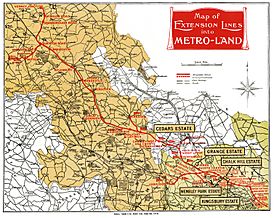
Several train and London Underground lines go through Willesden. You can find stations like:
- Dollis Hill tube station (Jubilee line)
- Willesden Green tube station (Jubilee line)
- Willesden Junction station (Bakerloo line and London Overground)
The Jubilee line connects Willesden directly to places like Stanmore (northbound) and Central London (southbound). Important stops southbound include Baker Street, Bond Street, Westminster, Waterloo, and Canary Wharf. Most southbound trains end at Stratford.
Northbound Bakerloo line trains from Willesden Junction usually end at nearby Stonebridge Park. Some trains continue to Wembley Central and Harrow & Wealdstone. Southbound Bakerloo line trains also go through Central London, stopping at places like Paddington, Marylebone, Baker Street, Oxford Circus, Waterloo, and Elephant & Castle.
Metropolitan line trains pass through Willesden Green and Dollis Hill but do not stop there anymore. Willesden Green station was actually opened by the Metropolitan Railway in 1879, and the area grew a lot because of this railway. Today, if you want to use the Metropolitan line from Willesden, you can take the Jubilee line and change trains at Wembley Central (north) or Finchley Road (south).
Willesden Junction is also served by several London Overground lines:
| Line | Direction | Terminus | Calling at... |
|---|---|---|---|
| Watford DC line |
Northbound | Watford Junction |
Harlesden, Stonebridge Park, Wembley Central |
| Watford DC line |
Southbound | Euston |
Kensal Green, Queen's Park |
| North London line |
Eastbound | Stratford |
Kensal Rise, Brondesbury Park, Brondesbury, West Hampstead, Finchley Road & Frognal, Hampstead Heath, Gospel Oak |
| North London line |
Westbound | Richmond |
Acton Central, South Acton, Gunnersbury |
| West London line |
Westbound | Clapham Junction |
Shepherd's Bush |
Stations in Willesden are in London fare zones 2 and 3.
Roads and Buses
Many important roads go through or around Willesden:
| Route | Road | Southbound/Westbound | Northbound/Eastbound |
|---|---|---|---|
| A219 | Scrubs Lane | White City | - |
| A404 | Harrow Road/Manor Park Road | Kensal | Wembley |
| A406 | North Circular Road | Ealing
|
Brent Cross
|
| A407 | High Road | Willesden Junction | Cricklewood |
| A4000 | Old Oak Lane | Acton | - |
| A4003 | Willesden Lane | - | Kilburn |
| A4088 | Dudding Hill Lane | - | Wembley |
| A5 | Shoot Up Hill | Kilburn | Cricklewood
Brent Cross |
A large bus garage was built in Willesden in 1902. Because of this, many bus routes start or pass through the town. The Queen even visited it during her Golden Jubilee celebrations. Some of the London Buses routes that serve Willesden are: 6, 52, 98, 206, 226, 260, 266, 297, 460, and N98.
Cycling Routes
To the north of Willesden, there's a quiet cycling path called Quietway 3. It runs smoothly between Gladstone Park and Shoot Up Hill on calm, residential streets. This route is managed by Transport for London (TfL) and is planned to extend east into West Hampstead towards Regent's Park.
There's also a direct, traffic-free cycle route south of Willesden along the Grand Union Canal towpath. Cyclists share this path with people walking. This towpath offers a continuous, traffic-free connection to Paddington. From Paddington, cyclists can connect to other parts of Central London using the traffic-free Cycle Superhighway 3.
Famous People from Willesden
- Ronald Coase (1910–2013), who won a Nobel Prize in Economics, was born and grew up in Willesden.
- Graham Cole, an actor.
- Ernest Eldridge (1897–1935), a racing driver.
- John Neville (1925-2011), an actor.
- Ben Smith, also known as Doc Brown, is an underground British rapper. He is the younger brother of author Zadie Smith. He mentions living in Brent, the borough Willesden is in.
- J. Keighley Snowden (1860-1947), an author and journalist, lived and passed away here.
- Kelvin Krash, a Trap music producer.
Willesden in Books and TV
Willesden has appeared in many popular books, TV shows, and songs:
- In the movie Last Chance Harvey, Emma Thompson's character says she lives in Willesden Green.
- The town is featured in the popular novels White Teeth and NW by Zadie Smith. White Teeth was even made into a TV series.
- Joe Strummer and the Mescaleros have a song called "Willesden to Cricklewood" on their album Rock Art and the X-ray Style.
- Willesden is where the 1980s breakdance group, the Willesden Dodgers, was formed.
- "Willesden Green" is the name of a song by the Kinks, written by Ray Davies. It was part of the soundtrack for the 1971 film Percy. The lyrics talk about missing home in Willesden Green.
- Willesden Green is a recurring joke in the animated TV cartoon series Danger Mouse.
- The Last Detective (2002) was filmed in and around Willesden, using The Rising Sun pub as a main location.
- The TV show Jonathan Creek is often filmed around Willesden.
- The Bonzo Dog Doo-Dah Band mention Willesden Green in their song "Shirt" from their 1969 album Tadpoles.
- Lead Balloon, a BBC4 comedy show starring Jack Dee, is mainly filmed in Willesden.
- In the book The Curious Incident of the Dog in the Night-Time, Christopher's mother lives in Willesden.
- Willesden was the first home of Jive Records, a music company that released music by famous artists like Britney Spears.
- The family in the BBC's 1992 sitcom So Haunt Me lived on Meadow Road, Willesden.
- In the popular 1980s/90s TV show Minder, Arthur Daley had a storage unit full of questionable items in Willesden. He also did many of his deals in the area.
- Willesden was once home to Morgan Studios, where many famous rock albums by bands like Yes and Led Zeppelin were produced. It was the first studio to use 24-track recording.
- In Nines' "Can't Blame Me" music video, the rapper is seen riding his bike down Willesden Lane.
See also
 In Spanish: Willesden para niños
In Spanish: Willesden para niños



